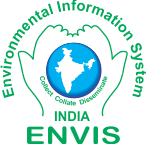Issues: 1 2 3 4 5 6 7 8 9 10 11 12 13 14 15 16 17 18 19 20 21 22 23 24 25 26 27 28 29 30 31 32 33 34 35 36 37 38 39 40 41 42 43 44 45 46 47 48 49 50 51 52 53 54 55 56 57 58 59 60 61 62 63 64 65 66 67 68
Vinay. S1,2, Bharath, S1, Chndran, M. D. S1,Bharath, H. A1,3, Shashishankar, A2,4, Ramachandra. T. V1 1. Abstract Hydro-Ecological footprint of a river basin refers to the hydrological regime that caters to biotic and environmental water requirements.Eco-Hydrological footprint provides information about the ecological status of water in addressing water usage with the availability. Mismanagement of the catchment and anthropogenic over exploitation of water resources have led to immense pressures on the natural ecosystems. In the current study, we focus on Sharavathi river basin, which originates in the Western Ghats and flows about 128 km towards Arabian Sea. Land use assessment in Sharavathi basin shows forest cover of 42.8%, which are dominated towards the Ghats. The uplands (plains towards the east) are dominated by agriculture activities, whereas the valleys in the Ghats show high horticulture activities. Monitoring of hydrologic regime of rivers/streams along with land use dynamics and topographic conditions reveal that in a natural landscape dominated by native species of vegetation, at least 25 to 30% of total flow occurs during post monsoon catering to the biotic water demand in the respective catchment. Also, higher species diversity are found in the stream catchments with the perennial streams and also catering the domestic and environmental needs. Hydro-Ecological footprint in Sharavathi basin shows sufficient water availability during all seasons in the streams dominated by native forests, which are in Ghats and Coasts. However, transition zones between Ghats and Plains, and Plain lands with largespatial extent of monoculture, and agricultural activities have led to water scarcity over 4 months and 6 months respectively. Ghats and Coasts have perennial streams as against the eastern transition where the stream flows were intermittent to seasonal. This highlights the vital ecological function of a catchment in sustaining the hydrologic regime when the landscape is covered with the vegetation of native species. The presence of perennial streams in sub-catchment dominated by native vegetation compared to the seasonal streams in the catchment dominated by anthropogenic activities with monoculture plantations, highlights the linkages of biodiversity, ecology and hydrologic regime with the landscape dynamics in the catchment. NEXT
|

